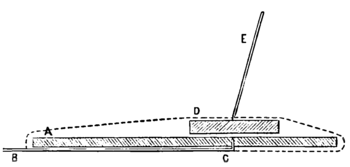crowded out of its original position between the marginal bones of the second or epipodial series into the third or mesopodial series. In icthyosaurus, the intermedium is not entirely excluded from the third row; in plesiosaurus and all other reptiles the process is essentially completed. In some amphibians, the bone still separates the lower end of the two specialized bones above it. Sauranodon marks an earlier and most interesting stage in the differentiation, and indicates how the transition was accomplished. Some of the amphibians retain remnants of a sixth digit, and icthyosaurus often presents traces that represent lost digits; but with these exceptions the normal number of five digits is not exceeded in any other air-breathing reptile than sauranodon.
To pierce Glass with the Electric Spark.—In the usual process of piercing glass with the electric spark when the glass is thick, one of the wires has to be inserted in a bed of insulating resin, quite thick, and which has itself to be melted upon the plate of glass. The operation, involving the use of heat, is inconveniently long; and, besides, the trouble of cleaning the glass of the resin has to be gone through after the hole is made. The process described below by M. Fages, architect of the city of Narbonne, is easy of application, and requires only a few minutes for preparation and execution. The apparatus is so simple that any one can construct it for himself, and it may be used for an indefinite number of operations. The cut represents it in vertical section. It consists of 1.—A rectangular plate, A, of hardened, black India-rubber, which should be, for a coil giving a spark of four inches, not less than six inches long and four inches wide; 2. A brass wire, B, the bent point of which, C, screwed or pushed into the India-rubber plate, rises even with its top. To use the apparatus, we lay it horizontally on a table, and put the brass thread B in connection with one of the poles of the magnetic coil; then pour some drops of olive or other oil on the India-rubber plate above the point C, and put upon it the plate of glass D, which is to be pierced, taking care that no bubbles of air are inclosed. The oil causes the insulation of the point C. This done, connect the wire E with the other pole of the coil and produce the spark. It is very easy, by moving the glass along, to make a number of holes as close to each other as may be desired. The only precaution necessary is to have the India-rubber plate large enough—so large that it will not be possible for the spark to jump between the wires by following the routes indicated by the dotted lines.
An Electrical Railway.—Mr. Werner Siemens exhibited an electrical railway at the recent exposition in Berlin, with which he attained a fair degree of success in transmitting electrical power to a distance, and applying it to the movement of carriages. This apparatus consists of a dynamo-electric machine fixed in the station supplying force to a second machine placed on a locomotive-carriage and connected with it by the rails of the track and a third rail which is insulated in the middle of the track. The electrical current is transmitted from the generating machine to the locomotive through the middle rail, and is returned through the wheels and the rails of the track. The carriages to be drawn by the locomotive are all electrically connected with it, so that communication is established through all the wheels. The train exhibited by Mr. Siemens consisted of the locomotive and three carriages with seats for six persons each.

